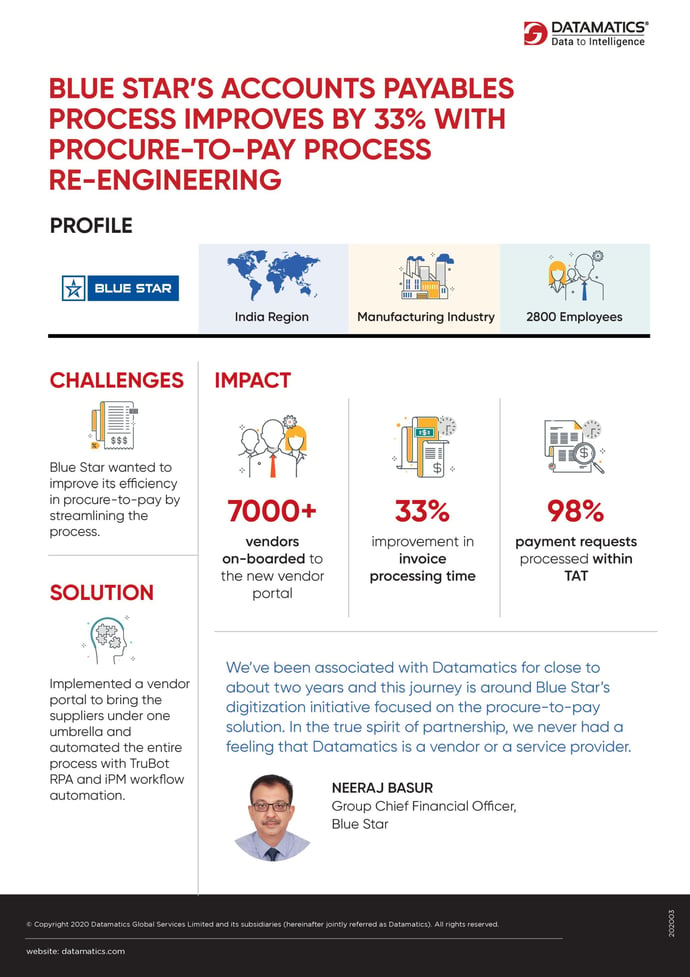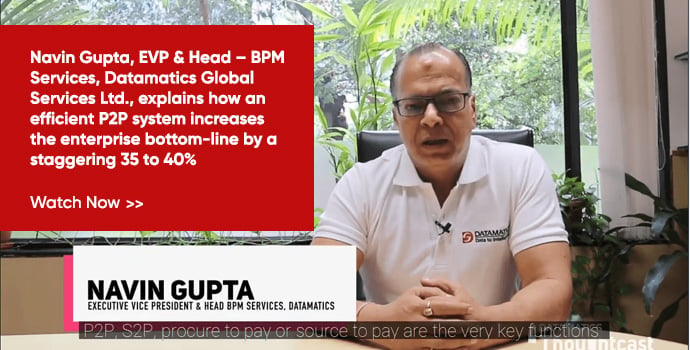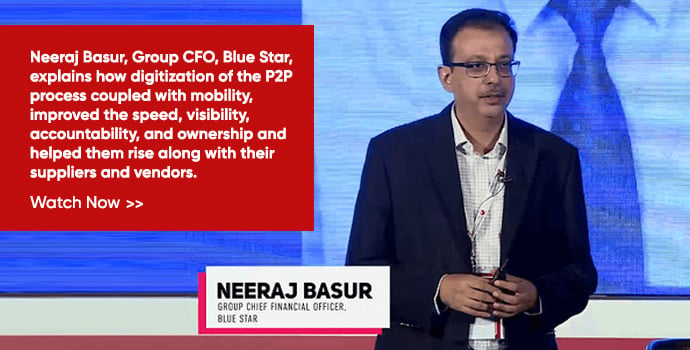8 enterprise best practices for optimizing the P2P process and building a JIT culture
by Navin Gupta, on Jan 2, 2020 6:58:23 PM
Estimated reading time: 3 mins
Manufacturing enterprises aim to build a just-in-time (JIT) culture. Inventory-carrying cost is usually high with your investments locked-up without immediate realization of incurred costs. JIT is the ideal scenario, where you have the least inventory, thereby registering savings of the highest order.

Sourcing just in time enables you to reap savings and pass on the resulting savings to your customer in terms of baked in discounts for providing a faster lead time. However, for the JIT ethos to sink in, you need to build a sound Procure-to-Pay (P2P) process ground work across your supply chain. Undoubtedly, to achieve this goal, you need to use Business Process Management (BPM) software, such as Robotic Process Automation (RPA) and Intelligent Automation (IA) on top of your ERP systems. Alternatively, you need to engage BPM services.
Even today, most enterprises deal with extensive manual paperwork in the procurement process; sometimes even while having an ERP system in place. The reason being with the proliferation of technology developments, these ERPs are fast becoming legacy in the highly automated business world.
The ERPs have gaps such that human intervention is required for manual document processing, validating checks and balances as well as authorizations across hierarchies. The manual processing is so messed-up that sometimes invoices are raised for rejected goods and supplies. To top it all, the maverick spend on supplies builds in risk and inefficiency in procuring raw material resulting in a direct impact on the bottom line and thus the sustenance of the business.
A streamlined P2P process through digital transformation across the value chain is the way ahead. It is in fact the backbone of a JIT culture. An algorithm-based business logic can completely eliminate manual process cycles except for very high value items. It can automate the min-max planning, institutionalize direct procurement process through a centralized procurement outfit and reduce tailspend.
Enterprise best practices for building a JIT culture
8 enterprise best practices for optimizing the P2P process and building a JIT culture:
- Vendor management
- Core strategic sourcing applications
- Quality compliances
- Low vendor lead time
- Cloud-based P2P solutions
- Integrated vendor management and P2P cloud system
- End-to-End automation
- Visual Analytics
- Vendor management: Create a comprehensive database of vendors, who offer shorter lead times for supplies and offer value for money. Simultaneously, build a sound Product and Service Catalog for centralized catalog planning and procurement. It helps to centralize all procurement and curb maverick spend.
- Core strategic sourcing applications: These include interoperable functionalities for e-sourcing, contract lifecycle management (CLM), supply base management (SBM), and spend analysis. Together, these functions form a strategic sourcing suite that functions across the value chain. These applications help in curbing longer procurement cycles, enable JIT manufacturing, help do away with heavy inventories, and add to the enterprise bottom-line.
- Quality compliances: Build efficient contracts with built-in clauses of right-to-return of unused supplies and components. Additionally, include penalties for supplies that are not up to the specified requirement.
- Low vendor lead time: Bake-in this particular KPI in the contract with measurement in days and hours. The quick time to fulfill an order with high quality supplies ranks the vendor higher in the vendor management system. The next time you are in a better position to knock the right door.
- Cloud-based P2P solutions: A cloud-enabled P2P system, which provides real-time and concurrent access to enterprise, vendor, and clients, nurtures the JIT manufacturing process even with supply as well as value chains spanning across geographies.
- Integrated vendor management and P2P cloud system: This integration enables you to quickly raise requisitions on the vendor, create purchase orders, acknowledge receipts, and create invoices. It further expedites the 3-way matching and payment process through an anytime, anywhere access. This integration enables you to reduce risk, optimize spend, improve compliance, and optimize the P2P cycle towards a JIT environment.
- End-to-End automation: A siloed architecture peppered by both new and old enterprise systems can be synchronously weaved together by using digital forms, digital automation solutions, and workflows. This enterprise transformation in to a digital workflow enables you to achieve an end-to-end automation that seamlessly connects the old with the new.
- Visual Analytics: P2P is a spend-heavy area. It mandates transparency in operations. A built-in Visual Analytics module enables you to check the end-to-end status, right from procurement of a small nut-bolt to the payment for a core component.
Business impact
Core business KPIs fulfilled through P2P-enabled JIT culture:
- Reduced inventory carrying cost
- Zero tail-spend
- Centralized procurement
A streamlined P2P process helps you to fulfill the core business KPIs:
- Significantly reduce inventory carrying cost that fluctuates as per the changing cost of the raw material
- Eliminate tail-spend that encompasses nearly 70% of the invoice processing
- Facilitate centralized procurement and vendor management towards a more streamlined F&A section
P2P benchmarks for improved efficiency |
Download Infographic >>
Success Story: Blue Star P2P Process Re-engineering
P2P process re-engineering enabled Blue Star to scale-up their business as well as that of their entire value chain. The end-to-end transparency and visibility, stepped-up collaboration and productivity across their multi-business environment.
P2P process re-engineering improved AP process by 33% for Blue Star |
Download Infographic >
In summary
ERP automation has been around for quite some time in Manufacturing enterprises. However, the changing business scenarios and the resulting requirements mandates stepping-up your P2P process with time. The ensuing P2P efficiency not only enables you to thrive on a “JIT culture on steroids” but also enables you to pass on the savings to your customers while still playing it high on your quality standards.




















